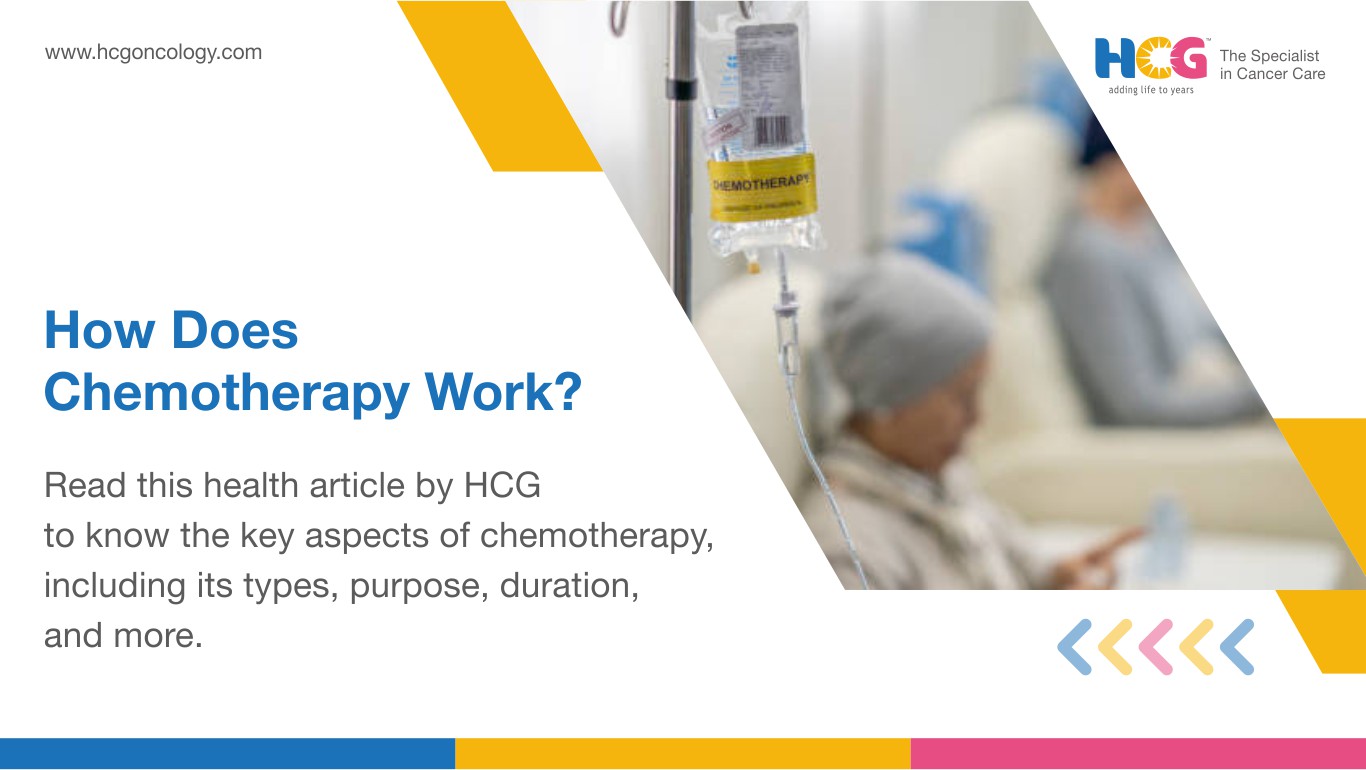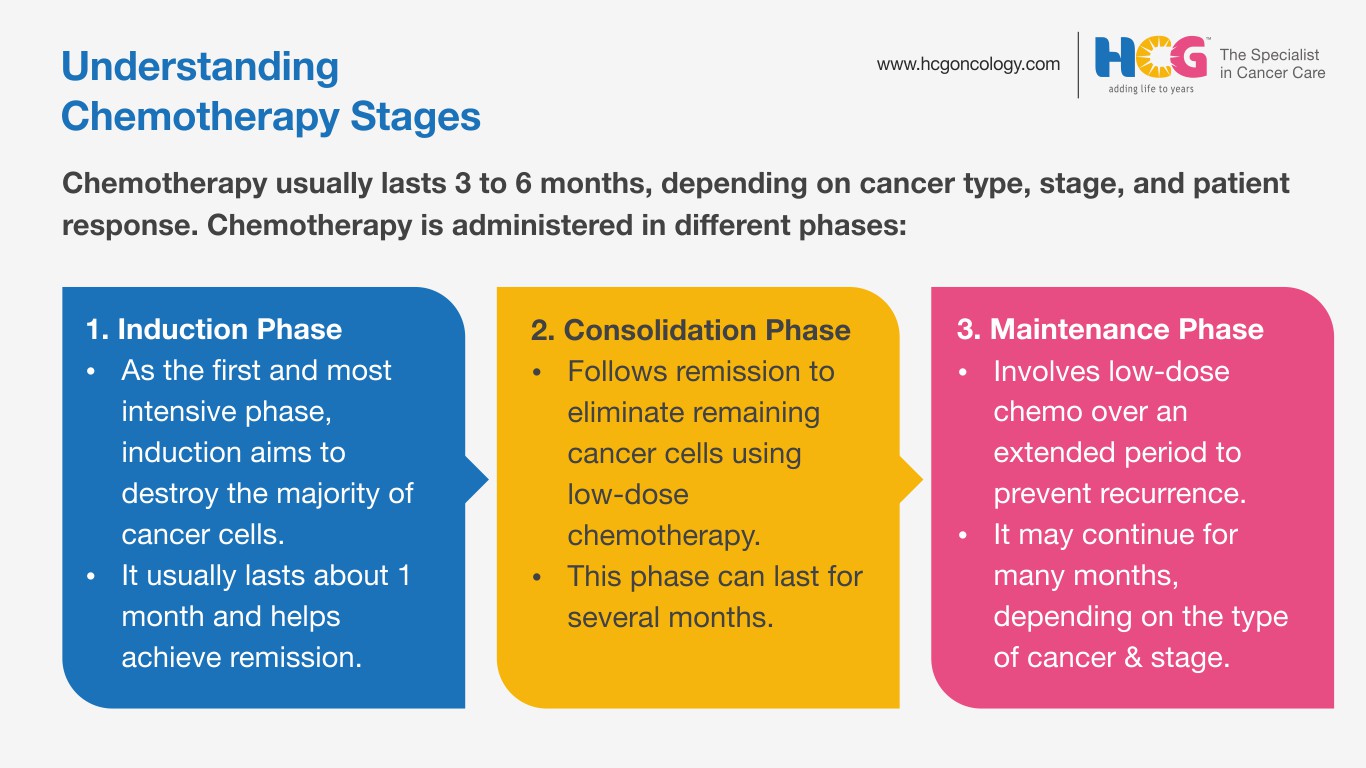
02 Dec, 2025
Feel free to reach out to us.

02 Dec, 2025
.png)
This article is medically reviewed by Dr. Siddharth Lath, Consultant - Medical Oncology, HCG Aastha Cancer Centre, Ahmedabad.
Chemotherapy is one of the primary and most common treatments for various types of cancer. It uses cytotoxic or cytostatic drugs (drugs that kill or stop the growth of malignant cells) to manage cancer.
Chemotherapy works by killing rapidly dividing cells, including cancer cells, through various mechanisms. The purpose of chemotherapy is to treat cancer and to manage symptoms in palliative care.
Chemotherapy, as an adjunctive therapy, enhances the efficacy of various other treatment modalities, such as radiation therapy and surgery. In most cases of cancer, chemotherapy is administered as a combination of multiple drugs rather than monotherapy for a more desirable chemotherapy success rate. The common routes of chemotherapy administration include oral, intravenous, and topical.
Some of the common types of chemotherapy drugs used in cancer treatment are:
Alkylating agents are used to treat various cancers, such as breast cancer, lung cancer, ovarian cancer, lymphoma, leukemia, multiple myeloma, and sarcoma. These drugs damage the DNA of rapidly dividing cells, interfering with the reproduction and spread of cancer cells.
Nitrosoureas exhibit their cytotoxic and antitumor activities by damaging the DNA of cancer cells. One advantage of using these agents is their ability to cross the blood-brain barrier. Thus, these drugs are also used in the treatment of various types of brain tumors. Some cancers treated by nitrosoureas are malignant glioblastomas, pancreatic islet cell tumors, Hodgkin’s and non-Hodgkin’s lymphomas, and multiple myeloma.
Antimetabolites are chemotherapy drugs that interfere with DNA replication and stop the reproduction of cells. These drugs inhibit the replication of DNA. Based on their target molecule, these drugs are classified into purine antagonists, pyrimidine antagonists, and antifolates. Some of the cancers effectively treated with antimetabolites are gastrointestinal cancer, breast cancer, ovarian cancer, leukemia, and pancreatic cancer.
Several antibiotics are used to treat cancer. Studies have reported their efficacy in inhibiting cancer growth and preventing cancer metastasis. The most common anticancer antibiotics used are anthracyclines. These drugs inhibit the enzyme involved in DNA replication. They are effective against breast cancer, lymphoma, acute myeloid leukemia, and acute lymphocytic leukemia.
Topoisomerase is an enzyme that assists in separating the DNA strand. Topoisomerase inhibitors inhibit this enzyme, resulting in DNA damage and cell death. Some of the cancers that can be treated with topoisomerase inhibitors are cervical cancer, renal cell cancer, small cell lung cancer, colorectal cancer, ovarian cancer, lymphoma, and leukemia.
Mitosis is the process of cell division that involves splitting a single cell into two cells. Mitotic inhibitors inhibit mitosis in cancer cells. Mitosis involves several steps, and these drugs interfere with one or more functions. The most effective mitotic inhibitors are antimicrotubule drugs. These drugs are further classified into taxanes and vinca alkaloids. Mitotic inhibitors are used to treat lymphoma, myeloma, breast cancer, lung cancer, and leukemia.
Corticosteroids are primarily recommended to manage side effects caused by different cancer treatments, including chemotherapy drugs. Steroids can help cancer patients with certain treatment-related side effects like nausea and vomiting, fatigue, allergic reactions, and pain associated with the disease metastasis. Studies have reported their use in patients with cancer in specific indications, such as superior vena cava syndrome, spinal cord compression, bowel obstruction, and raised intracranial pressure due to brain metastasis.
Several patients, during consultation, ask about how chemotherapy works. The cell cycle is a process through which new cells are formed. There are several phases of the cell cycle. These phases include increasing cell size, DNA replication, preparation for division, and division (mitosis).
Chemotherapy drugs inhibit various processes at different stages of the cell cycle. Medical oncologists have specialized training in systemic therapies, and they will have a detailed understanding of each chemotherapy drug’s mechanism of action and its effect on a particular cell cycle phase. For each case, they carefully assess the type of cancer, its stage, grade, and other factors before recommending the right chemotherapy drug. This personalization is crucial for a better disease prognosis and superior treatment outcomes.
As chemotherapy drugs cannot differentiate between cancer cells and healthy cells, medical oncologists pay special attention to optimizing the balance between the efficacy and side effects of the drugs.
Chemotherapy works by killing and stopping the growth of cancer cells through several mechanisms. Medical oncologists may prescribe chemotherapy drugs in combination to provide a synergistic effect, as the combined drugs may act on different cell cycle stages. This will improve the overall treatment outcomes.
The mechanism of action of chemotherapy drugs varies with their classes. While alkylating agents damage the DNA of cancer cells, antimetabolites substitute the RNA and DNA blocks, thereby interfering in DNA replication. Antitumor antibiotics interfere with the functioning of the DNA-replicating enzymes, and topoisomerase inhibitors inhibit the topoisomerase enzyme required for unwinding the DNA. Mitotic inhibitors possess anti-mitotic activity that prevents cell growth and division.
Chemotherapy works in the following ways for different types of cancer. These include:
Treating or stopping cancer: Chemotherapy treatment is used to induce remission and minimize the chances of its recurrence.
While treating cancer, these drugs directly interfere with vital processes and kill the cancer cells. These drugs are known as cytotoxic agents and help in tumor shrinkage.
Some of the drugs are cytostatic, as they inhibit tumor growth and have no direct cytotoxicity.
Palliative care: Chemotherapy is also a component of palliative care. It helps reduce the severity of cancer-related symptoms and may be used in combination with radiation therapy or surgery.
Chemotherapy involves the administration of cytotoxic and cytostatic drugs. The therapy does not differentiate between cancer cells and healthy cells. Thus, it can affect all body cells, especially rapidly dividing cells. In addition, chemotherapy is usually delivered systemically, i.e., it travels in the blood and reaches all the organs. This further worsens the side effect profile of this therapy.
Bone marrow cells, hair follicles, and cells of the intestine, stomach, oral cavity, and reproductive system are some of the cells vulnerable to chemotherapy drugs because of their faster multiplication rate, just like cancer cells.
Patients on chemotherapy are also at higher risk for developing conditions related to the kidneys, nervous system, lungs, bladder, and heart. Medical oncologists prescribe appropriate medications to manage the side effects of chemotherapy preemptively before each cycle of chemotherapy.
The usual duration of chemotherapy is 3 to 6 months. However, it may be longer or shorter based on different factors. These include the type of cancer, the stage at which the cancer is diagnosed, the overall patient's health, the tolerability of chemotherapy, the time to recover from chemotherapy side effects, and the response to treatment.

There are various phases or stages of chemotherapy, including induction, consolidation, and maintenance. Administering chemotherapy drugs in different phases plays a critical role in patients achieving long-term remission and reducing the risk of recurrences.
This is the initial, intense phase of chemotherapy, wherein higher doses of chemo drugs are administered to destroy as much cancer cells as possible relatively quickly and help patients enter remission. It may last for about one month.
Once the patient enters remission, consolidation chemotherapy is administered, wherein chemo drugs are infused in a smaller dose or fewer drugs are used to destroy residual cancer cells. This phase may last for a few months.
During the maintenance phase, chemotherapy is administered in lower doses for many months. The goal of this phase is to reduce the risk of recurrences.
HCG Cancer Centre is one of the well-known cancer hospitals in India. We specialize in delivering customized chemotherapy regimens for a wide range of cancers. The medical oncologists at our hospital are highly experienced in managing various cancers through multimodal treatment plans involving chemotherapy and other systemic therapies. During follow-up visits after the treatment, patients are consistently monitored for chemotherapy-induced side effects and response to treatment.
Chemotherapy involves administering cytotoxic drugs to treat cancer. Various classes of chemotherapy drugs are available, such as alkylating agents, nitrosoureas, mitotic inhibitors, corticosteroids, topoisomerase inhibitors, antitumor antibiotics, and antimetabolites. These cancer medicines treat cancer through different mechanisms. Combination chemotherapy may provide synergistic action.
.png)
Dr. Siddharth Lath
Consultant - Medical Oncology
MBBS, DNB (General Medicine), DrNB (Medical Oncology)
Dr. Siddharth Lath is a skilled medical oncologist who is trained to administer systemic therapies and stem cell transplants for various types of cancer. He is available for consultations at HCG Aastha Cancer Centre, a leading oncology hospital in Ahmedabad. Dr. Siddharth’s care approach involves adopting patient-friendly treatment techniques and staying current with the latest advancements in the field of medical oncology. Among his patients, he is known for his calm demeanor and how he prioritizes planning customized care plans for his patients and makes their overall well-being a priority.
To book an appointment with Dr. Siddharth Lath, please click here.